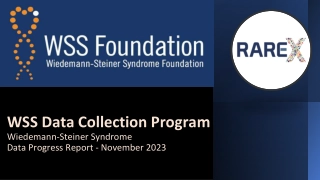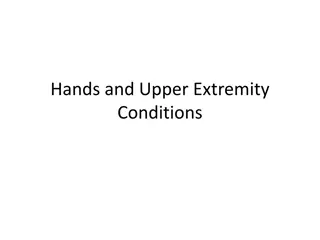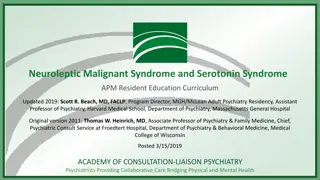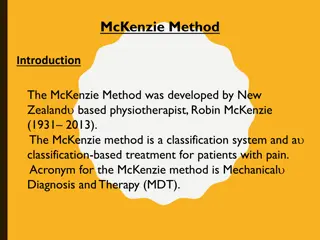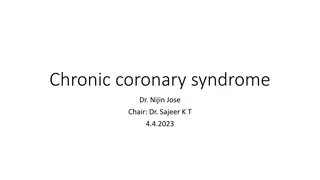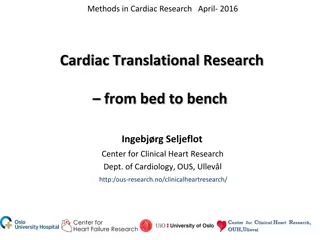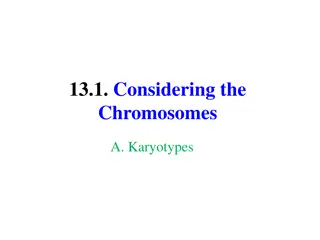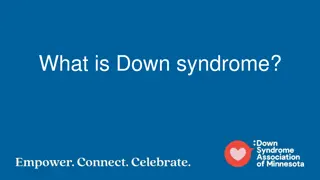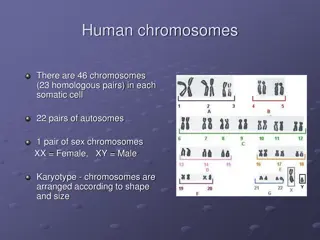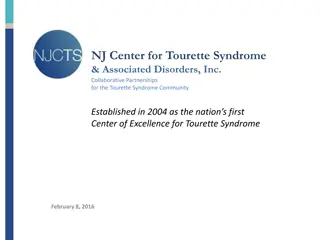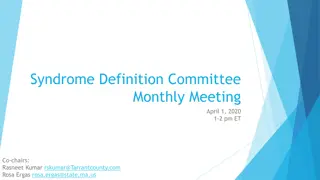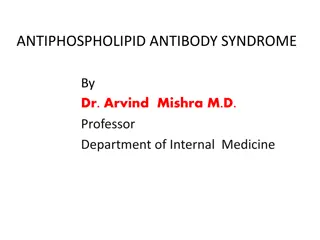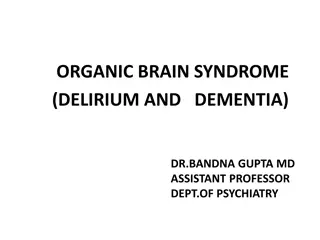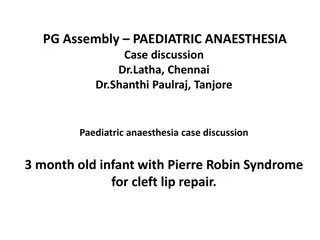Understanding Wernicke-Korsakoff Syndrome: Overview and Clinical Considerations
Wernicke-Korsakoff Syndrome (WKS) comprises Wernicke's Encephalopathy (WE) and Korsakoff Syndrome. WE presents with altered mental status, ocular signs, and ataxia, while Korsakoff Syndrome manifests as amnesia and confabulations. Untreated WE can progress to Korsakoff Syndrome in about 80% of cases. Timely diagnosis and treatment are crucial, as WKS has a high prevalence in alcohol-dependent individuals. This presentation by Sue Fosnight covers symptomatology, pathophysiology, treatment recommendations, and reversibility of WKS.
Download Presentation

Please find below an Image/Link to download the presentation.
The content on the website is provided AS IS for your information and personal use only. It may not be sold, licensed, or shared on other websites without obtaining consent from the author. Download presentation by click this link. If you encounter any issues during the download, it is possible that the publisher has removed the file from their server.
E N D
Presentation Transcript
Wernicke-Korsakoff Syndrome By Sue Fosnight RPH, BCGP, BCPS October 2022
Objectives At the end of this presentation, the listener should be able to: 1. Explain the relationship between Wernicke s Encephalopathy (WE) and Korsakoff Syndrome(KS) 2. Identify symptoms of WE and KS 3. Discuss the pathophysiology of WE and KS 4. Explain treatment recommendations for these conditions and evidence associated with these recommendations 5. Apply above information to patient case
Wernickes Encephalopathy Described by Carl Wernicke in 1881 Triad of altered mental status, ocular signs, and ataxia Considered the acute phase of Wernicke- Korsakoff syndrome (WKS) Oudman E, et,al. J Neurol Sci. 2021;426:117482. doi: 10.1016/j.jns.2021.117482. Creative Commons: Assessed 6-4-22
Korsakoff Syndrome Described by Sergei Korsakoff in 1887 Amnesia with confabulations Considered the chronic phase of Wernicke- Korsakoff syndrome (WKS) Oudman E, et,al. J Neurol Sci. 2021;426:117482. doi: 10.1016/j.jns.2021.117482 Sinha S, et al. Mayo Clin Proc. 2019 Jun;94(6):1065-1072 Creative Commons: Assessed 6-4-22
Is Wernicke-Korsakoff Syndrome Reversible?
Is Wernicke- Korsakoff Syndrome Reversible? Wernicke Encephalopathy is usually reversible Korsakoff Syndrome is usually not reversible Dingwall KM, et. al. Alcohol Clin Exp Res. 2022;. doi: 10.1111/acer.14843 Pruckner N, et.al. Eur Addict Res 2019;25(3):103-110. Oudman E, et,al. J Neurol Sci. 2021;426:117482. doi: 10.1016/j.jns.2021.117482.
How often does untreated Wernicke s Encephalopathy progress to Korsakoff Syndrome ?
How often does untreated Wernicke s Encephalopathy progress to Korsakoff Syndrome ? Approximately 80% of patients with untreated WE will progress to Korsakoff syndrome Sinha S, et al. Mayo Clin Proc. 2019 Jun;94(6):1065-1072 Pruckner N, et.al. Eur Addict Res 2019;25(3):103-110.
Epidemiology Epidemiology More than 90% of WKS cases have been diagnosed in alcohol dependent patients Prevalence of Wernicke s Encephalopathy (WE) in United States reported to be 0- 2.2% European Federation of Neurological Societies guidelines state that Wernicke s encephalopathy is not a rare disorder, but rather a rare diagnosis About 80% of WKS cases are reported to not being diagnosed On autopsy it is reported that WE lesions are present in 12% of patients and 29% 59% in deaths related to alcohol use It is estimated that 75% of patients with undiagnosed and untreated WE will have permanent brain damage Mortality has been reported in about 20% for those with undiagnosed or untreated WE Sinha S, et al. Mayo Clin Proc. 2019 Jun;94(6):1065-1072 Dingwall KM, et. al. Alcohol Clin Exp Res. 2022;. doi: 10.1111/acer.14843 Pruckner N, et.al. Eur Addict Res 2019;25(3):103-110. Sechi G, et.al.. Lancet Neurol 2007;6(5):442-455 Chandrakumar A, et.al . J Basic Clin Physiol Pharmacol 2018;30(2):153-162.
Original Diagnostic Criteria for Wernickes Encephalopathy Mental Impairment Approximately 90% of patients with WE do not have all three criteria Eye Ataxia Changes Eye Changes = Nystagmus , Lateral rectus palsy , Conjugate gaze palsy , Internuclear ophthalmoplegia, Unequal pupils, Light-near dissociation, Retinal hemorrhage, Papilledema Dingwall KM, et. al. Alcohol Clin Exp Res. 2022;. doi: 10.1111/acer.14843
MRI Findings Not very sensitive for alcoholic WKS, better for non-alcoholic WKS Lesions surrounding the third and fourth ventricle or aqueduct with ventricular expansion Atrophy of mammillary bodies Atrophy in thalamic area Pruckner N, et.al. Eur Addict Res 2019;25(3):103-110. Sullivan EV, et.al.Alcohol Alcohol. 2009;44(2):155-65. Oudman E, et,al. J Neurol Sci. 2021;426:117482. doi: 10.1016/j.jns.2021.117482
Wernickes Encephalopathy Diagnosis Criteria : 2022 Proposed Revision of Diagnostic Criteria in Alcohol Dependent Patients by Caine (1997) Two of four of the following symptoms are present Altered Mental State Change or Mild Memory Impairment Oculomotor Abnormalities* Cerebellar Dysfunction Dietary Deficiency 2012 British Association for Psychopharmacology (BAP) Guidelines : Presumptive diagnosis if history of alcohol dependence and any of triad symptoms or unexplained hypotension, hypothermia, coma, or unconsciousness Some say to treat if nutritional deficiency and any one of the triad symptoms *Oculomotor Abnormalities = Nystagmus , Lateral rectus palsy , Conjugate gaze palsy , Internuclear ophthalmoplegia, Unequal pupils, Light-near dissociation, Retinal hemorrhage, Papilledema Pruckner N, et.al. Eur Addict Res 2019;25(3):103-110. Dingwall KM, et. al. Alcohol Clin Exp Res. 2022;. doi: 10.1111/acer.14843 Sinha S, et al. Mayo Clin Proc. 2019 Jun;94(6):1065-1072 Lingford-Hughes, et.al . J Psychopharmacol. 2012;26(7):899-952
Korsakoff syndrome symptoms :2022 Cofabulation Anterograde amnesia Behavior issues El Haj M. Encephale. 2021; 47(4):356-361 Pruckner N, et.al. Eur Addict Res 2019;25(3):103-110.
What is the underlying cause of Wernicke- Korsakoff Syndrome ?
What is the underlying cause of Wernicke- Korsakoff Syndrome? Thiamine Deficiency
Thiamine Functions Thiamine Functions Essential for synthesis of neurotransmitters, nucleic acids, steroids and fatty acids. Essential for carbohydrate and cellular functions Co-enzyme in Krebs cycle Often need magnesium for optimum effect Effects membrane permeability of cells Neurotoxicity occurs with deficiency Deficiency occurs within 2 to 6 weeks without intake Creative Commons . Accessed 6-6-22 Nutt D, Hayes A, Fonville L, et.al.. Alcohol and the Brain. Nutrients. 2021;13(11):3938 Sechi G, et.al.. Lancet Neurol 2007;6(5):442-455 Chandrakumar A, et.al . J Basic Clin Physiol Pharmacol 2018;30(2):153-162
Thiamine Pharmacokinetics Absorption: Both Passive and Active Transport from Gut Active transport occurs when deficient levels in gut lumen Active transport is saturable Distribution Widely distributed ; limited storage in brain, kidney, heart, liver, and skeletal muscles Metabolism Converted to active form in liver Excretion Kidney Half life : In literature as a wide range from 1.5 hours to 19 days Not clear if free thiamine is being measured: Free thiamine half life =96 minute Smithline HA, et,al,.. BMC Clin Pharmacol. 2012;12:doi:10.1186/1472- 6904-12-4 Royer-Morrot Mj, et.al. Eur J Clin Pharmacol. 1992;42(2):219-222. doi:10.1007/BF00278489 Covell T, Siddiqui W. Korsakoff Syndrome. In: StatPearls. Treasure Island (FL): StatPearls Publishing; July 10, 2021 Nutt D, Hayes A, Fonville L, et.al.. Alcohol and the Brain. Nutrients. 2021;13(11):3938 Tallaksen CM,et al,. Eur J Clin Pharmacol 1993;44(1):73-78 Sechi G, et.al.. Lancet Neurol 2007;6(5):442-455 Chandrakumar A, et.al . J Basic Clin Physiol Pharmacol 2018;30(2):153-162 Galvin R, et.al. Eur J Nerurol 2010 :; 17:1408-1418.
Thiamine Deficiency Bottom Line = Cell Death This Photo by Unknown Author is licensed under CC BY-SA-NC
Malnutrition Causes of Thiamine Deficiency Chronic vomiting Poor Intake Alcohol Use Hyperemesis gravidarum Cancer Increased Demand- Sepsis, Critical Illness Bariatric surgery Chronic diarrhea Oudman E, et,al. J Neurol Sci. 2021;426:117482. doi: 10.1016/j.jns.2021.117482 Sinha S, et al. Mayo Clin Proc. 2019 Jun;94(6):1065-1072
Why does Wernicke-Korsakoff Syndrome occur frequently in patients with alcohol use disorder?
Poor nutrition: Alcohol beverages are filling, therefore decrease regular meal intake. Magnesium may also be low and magnesium is needed for thiamine to work efficiently Alcohol is high in carbohydrates so increases demand for thiamine Proposed Mechanisms of Thiamine Deficiency in Alcohol Use Disorder Reduced GI absorption of thiamine : Alcohol damages the mucosa of the gut which reduces intestinal thiamine active transport for absorption Decreased hepatic storage of thiamine Nutt D, Hayes A, Fonville L, et.al.. Alcohol and the Brain. Nutrients. 2021;13(11):3938 Decreased conversion to active form: Thiamine pyrophosphokinase and magnesium convert thiamine to its active form, thiamine pyrophosphate. Thiamine pyrophosphokinase is inhibited by alcohol and magnesium levels decrease with alcohol use Chandrakumar A, et.al . J Basic Clin Physiol Pharmacol 2018;30(2):153-162 Pruckner N, et.al. Eur Addict Res 2019;25(3):103-110. Dingwall KM, et. al. Alcohol Clin Exp Res. 2022;. doi: 10.1111/acer.14843 Metabolism of thiamine to thiamine pyrophosphate is decreased with cirrhosis Oudman E, et,al. J Neurol Sci. 2021;426:117482. doi: 10.1016/j.jns.2021.117482
Other Signs of Thiamine Deficiency Loss of appetite Diarrhea Fatigue Irritability Reduced reflexes Tingling sensations in arms and legs Blurred vision Oudman E, et,al. J Neurol Sci. 2021;426:117482. doi: 10.1016/j.jns.2021.117482
a. Thiamine 100 mg orally daily b. Thiamine 100 mg IVPB daily c. Thiamine 100 mg IVPB three times daily d. Thiamine 200 mg orally daily e. Thiamine 200 mg IVPB daily f. Thiamine 200 mg IVPB three times daily g. Thiamine 300 mg orally daily h. Thiamine 300 mg IVPB daily i. Thiamine 500 mg IVPB three times daily Which of the following would be most appropriate to prevent Wernicke s Encephalopathy?
a. Thiamine 100 mg orally daily b. Thiamine 100 mg IVPB daily c. Thiamine 100 mg IVPB three times daily d. Thiamine 200 mg orally daily e. Thiamine 200 mg IVPB daily f. Thiamine 200 mg IVPB three times daily g. Thiamine 300 mg orally daily h. Thiamine 300 mg IVPB daily i. Thiamine 500 mg IVPB three times daily Which of the following would be most appropriate for Wernicke s Encephalopathy treatment?
a. Thiamine 100 mg orally daily b. Thiamine 100 mg IVPB daily c. Thiamine 100 mg IVPB three times daily d. Thiamine 200 mg orally daily e. Thiamine 200 mg IVPB daily f. Thiamine 200 mg IVPB three times daily g. Thiamine 300 mg orally daily h. Thiamine 300 mg IVPB daily i. Thiamine 500 mg IVPB three times daily Which of the following would be most appropriate for a patient with chronic vomiting and new confusion ?
Limited and variable absorption It is reported that oral thiamine is minimally absorbed with about 4.5 mg absorbed from a 30 mg dose without increased absorption from higher doses From British Association for Psychopharmacology, Expert Reviewers Group in 2012: .there is growing consensus for using parenteral regimens in those with WE and also, importantly, for those at risk . Literature Guidance : Oral Thiamine? Day E, et.al. Cochrane Database Syst Rev. 2013;2013(7):CD004033. doi: 10.1002/14651858 Thomson AD. Alcohol Alcohol Suppl 2000;35(1):2-7. .
Literature Guidance :Are multiple doses per day needed? Half life of thiamine = variably reported : 1.5 hours to 19 days Free thiamine half-life= 96 min Multiple daily administrations might be needed to restore levels and allow for optimal blood brain diffusion Galvin, et. al. Eur J Neurol. 2010;17(12):1408-1418. doi:10.1111/j.1468-1331.2010.03153.x Tallaksen CM,et al,. Eur J Clin Pharmacol 1993;44(1):73-78 Smithline HA, et,al,.. BMC Clin Pharmacol. 2012;12:doi:10.1186/1472-6904-12-4 Royer-Morrot Mj, et.al. Eur J Clin Pharmacol. 1992;42(2):219-222. doi:10.1007/BF00278489
Why give thiamine infusion before a glucose load?
Guidelines Guidelines 2010 2010 European Federation of Neurological Societies For at risk patients: -200 mg IVPB x1 (EFNS) (EFNS) For suspected Wernicke Encephalopathy -200 mg IVPB three times daily until no further improvement in symptoms Galvin R, et.al. Eur J Nerurol 2010 :; 17:1408-1418.
Guidelines Guidelines Low risk patients : Healthy alcohol dependent or heavy drinkers 2012 British Association 2012 British Association for Psychopharmacology for Psychopharmacology -Thiamine>300 mg /day orally during detoxification (BAP) (BAP) High risk patients: Malnourished or chronically ill alcohol dependent or heavy drinkers -Thiamine 250 mg IV or IM once daily for 3-5 days or until no further improvement is seen IF WE suspected or established - Thiamine >500 mg /day IM/IV for 3 to 5 days, then 250 mg/ day IM/IV for another 3 to 5 days depending on response. Lingford-Hughes, et.al . J Psychopharmacol. 2012;26(7):899-952
Guidelines Guidelines 2018 Italian Society on 2018 Italian Society on Alcohol : Position Paper on Alcohol : Position Paper on the Treatment of Alcohol the Treatment of Alcohol For Alcohol Withdrawal Patients -Recommend to treat all patients -IV or IM Thiamine 200 mg daily for 3 to 5 days Withdrawal Withdrawal For WE patients -IV or IM Thiamine 500 mg every 8 hours for at least 3 days before glucose load is given -If peripheral neuropathy is present, thiamine should be continued orally at a dose of 300 mg per day until clinical improvement is achieved Caputo F, et.al. Alcohol. Intern Emerg Med. 2019 ;14(1):143-160
WE prophylaxis : Intramuscular administration of 250 mg thiamine once daily for 3 5 consecutive days. Established WE: Empiric treatment with a minimum of 500 mg thiamine i.v. or i.m., three times daily, for at least 2 days. If ataxia, polyneuritis, confusion or memory disturbance: Continue until clinical improvement Expert Opinion 2005 Agabio R, et.al. Alcohol.Alcohol 2005;40:155- 156.
WE Treatment IV thiamine: two to three pairs of Pabrinex *ampules every 8 h for 5 days, Multivitamins IV Correct magnesium deficiency: Correct fluid and electrolyte losses and Thiamine must always be given before a glucose load Expert Opinion 2013 *2 ampules of Pabrinex now reported to contain 250 mg of thiamine, 4 mg of riboflavin, 50 mg pyridoxine, 500 mg of ascorbic acid,160 mg of nicotinamide , 1000 mg of glucose per Pabrinex Intravenous High Potency, Concentrate for Solution for Infusion - Summary of Product Characteristics (SmPC) - (emc) (medicines.org.uk) Thomson AD, et.al. Alcohol Alcohol. 2013;48(1):4-8.
Expert Opinion 2013- Cochrane Review 2013 Cochrane Review Only 2 randomized controlled trials One with 8 patients and one with 169 patients of which 43 did not complete treatment Evidence from randomized controlled clinical trials is insufficient to guide clinicians in determining the dose, frequency, route or duration of thiamine treatment for prophylaxis against or treatment of WKS due to alcohol abuse. Day E, et.al. Cochrane Database Syst Rev. 2013;2013(7):CD004033. doi: 10.1002/14651858
Expert Opinion 2019 Many other guidelines mention use of thiamine, but without recommendations on dose or route To this date, there is no evidence-based consensus on dosage and treatment regimen for thiamine administration in patients with AUD or suspected WE , but the scarce data available suggest that higher dosages might be essential for patients benefits Pruckner N, et.al. Eur Addict Res 2019;25(3):103-110.
A randomized double-blind placebo-controlled trial of intravenous thiamine for prevention of delirium following allogeneic hematopoietic stem cell transplantation Randomized double-blind placebo-controlled trial in 66 patients getting a allogeneic hematiopoietic stem cell transplant (HSCT) Compared IV thiamine 200 mg tid for 7 days to 100 ml Normal Saline tid for 7 days, starting Day 1 of post transplantation Randomized in block randomization screen stratified by age and Montreal Cognitive Assessment (MOCA) score Inclusion criteria : 18 or over, able to provide consent , admitted for allogeneic HSCT, English speaking Exclusion criteria: Delirious, Pregnant, Adverse reaction to IV thiamine in the past Outcome = Delirium as measured by Delirium Rating Scale ( DRS) ( assessed on Day 1 up to Day 30 ) Design Pertinent Results Mean age -54 in both groups No significance difference in those positive for delirium between groups 25% in thiamine group and 21% in placebo group (p=0.73) 6.8% of patients in thiamine group and 8.8% of patients in placebo group had adverse effect (facial edema, restlessness, nausea , diarrhea, pain Comments No indicators for nutritional deficiency included in inclusion criteria . Nakamura ZM, et al.. J Psychosom Res. 2021;146:110503. doi:10.1016/j.jpsychores.2021.110503
What is the optimum thiamine dose to treat or prevent Wernicke's encephalopathy or Wernicke-Korsakoff syndrome? Results of a randomized controlled trial Randomized double-blind 3 arm parallel groups Trial 1= Asymptomatic at-risk patients, 393 patients randomized Design Inclusion criteria : 18 yo to 65 yo, history of heavy alcohol use in last 3 months per Audit C scores or 6 drinks/day or 8 drinks/binge, at nutritional risk* but displaying no neurological symptoms. Exclusion criteria: Pregnancy, acute neurological, or cognitive impairment clearly unrelated to presumed thiamine deficiency or WKS, intubation, vasopressor therapy for hypotension, dialysis treatment, acute exacerbation of a psychiatric illness, treatment with parenteral thiamine in the past 4 weeks, or received a stat im thiamine dose >300 mg prior to enrolment Intervention: Thiamine 100 mg IV daily for 3 days, 100 mg IV three times daily for 3 days, 300 mg IV three times daily for 3 days Outcomes Cognition: Rowland Universal Dementia Assessment Scale,Cog State, A Story Recall Memory Test ( SRMT) Neurological : Ataxia, Oculomotor Abnormalities, Confusion *Nutritional risk = 2 of the following : BMI <18 , or < 30, comorbid chronic illness (e.g., hepatic, respiratory, renal, thyroid disease, and diabetes) that is poorly controlled , biochemical markers indicated nutritional deficiency Ref =24 Dingwall KM, et. al. Alcohol Clin Exp Res. 2022;. doi: 10.1111/acer.14843
What is the optimum thiamine dose to treat or prevent Wernicke's encephalopathy or Wernicke-Korsakoff syndrome? Results of a randomized controlled trial Randomized double-blind 3 arm parallel groups Trial 1= Asymptomatic at-risk Patients, 393 patients randomized Pertinent Results No significant difference between any of the groups on any of the cognitive outcome measures except for Story recall test ( 100 mg IV tid did better than 100 mg IV daily or 300 mg IV tid) No significant difference between any groups for neurological measures Logistic regression analysis did not show that thiamine replacement made difference in Wernicke s symptoms at follow-up Dingwall KM, et. al. Alcohol Clin Exp Res. 2022;. doi: 10.1111/acer.14843
What is the optimum thiamine dose to treat or prevent Wernicke's encephalopathy or Wernicke-Korsakoff syndrome? Results of a randomized controlled trial Randomized double-blind 3 arm parallel groups Trial 2= Symptomatic Patients, 127 patients randomized Design Inclusion criteria : 18 yo to 65 yo, history of heavy alcohol use in last 3 months per Audit C scores or 6 drinks/day or 8 drinks/binge, and had two or more clinical signs of oculomotor abnormalities, ataxia, confusion, or nutritional risk Exclusion criteria: Pregnancy, acute neurological, or cognitive impairment clearly unrelated to presumed thiamine deficiency or WKS, intubation, vasopressor therapy for hypotension, dialysis treatment, acute exacerbation of a psychiatric illness, treatment with parenteral thiamine in the past 4 weeks, or received a stat im thiamine dose >300 mg prior to enrolment Intervention: Thiamine 100 mg IV 3 times daily for 5 days, 300 mg IV three times daily for 5 days, 500 mg IV times daily for 5 days Outcomes Cognition: Rowland Universal Dementia Assessment Scale,Cog State, A Story Recall Memory Test ( SRMT) Neurological : Ataxia, Oculomotor Abnormalities, Confusion *Nutritional risk = 2 of the following : BMI <18 , or < 30, comorbid chronic illness (e.g., hepatic, respiratory, renal, thyroid disease, and diabetes) that is poorly controlled , biochemical markers indicated nutritional deficiency Dingwall KM, et. al. Alcohol Clin Exp Res. 2022;. doi: 10.1111/acer.14843
What is the optimum thiamine dose to treat or prevent Wernicke's encephalopathy or Wernicke-Korsakoff syndrome? Results of a randomized controlled trial Randomized double-blind 3 arm parallel groups Trial 2= Symptomatic Patients, 127 patients randomized Pertinent Results No significant difference between any of the groups on any of the cognitive outcome measures No significant difference between any groups for neurological measures Logistic regression analysis did not show that thiamine replacement made difference in Wernicke s symptoms at follow-up Did not reach power Dingwall KM, et. al. Alcohol Clin Exp Res. 2022;. doi: 10.1111/acer.14843
Early treatment with thiamine and mortality among patients with alcohol use disorder who are hospitalized for pneumonia Design Retrospective Multicenter Cohort Trial of 36,732 patients using Premier database Inclusion criteria : Adult patients hospitalized for pneumonia with alcohol use disorder and treated with a benzodiazepine in the first 2 days of hospitalization. Intervention: Any thiamine treatment during initial two days of hospitalization , high dose thiamine treatment during initial two days of hospitalization Outcomes Mortality between 3 and 14 days of hospital admission Transfer to ICU after initial 2 days Discharge disposition Length of stay Statistics Each patient given a propensity score based on baseline demographics; insurance status; comorbidities; initial disease severity factors (inability to take oral medication, intensive care admission, invasive mechanical ventilation, and vasopressors on the first hospital day); and hospital geographic region Baron SW, et.al. J Hosp Med. 2022;17(8):585-593.
Early treatment with thiamine and mortality among patients with alcohol use disorder who are hospitalized for pneumonia Pertinent Results 36, 732 patients from 632 hospitals included 72.2% received thiamine in first two day of hospitalization Outcomes Mortality within 3 to 14 days of admission 6.5% ( thiamine group) versus 8.1% ( no thiamine group) Propensity adjusted rate significant (OR =0.8, 95% confidence interval :0.75 0.85, p < 0.001) Transfer to ICU after initial 2 days ( with propensity score adjustment) No significant difference (OR: 0.96, 95% CI: 0.91 1.03, p = 1) Discharge disposition (with propensity score adjustment) Thiamine administration increased likelihood for discharge home: (OR: 1.10, 95% CI: 1.06 1.14, p < 0.001) Length of stay (with propensity score adjustment) No significant difference OR=1.003, 95% CI: 0.99 1.02, p = 1) Baron SW, et.al. J Hosp Med 2022;17(8):585-593.
Reported adverse effects of thiamine Anaphylaxis Dyspnea/ Bronchospasm Rash Flushing Pharyngeal Edema Pulmonary Edema Thomson A, et.al. Alcohol Alcohol. 2019 ;54(6):609-614 Agabio R, et.al. Alcohol.Alcohol 2005;40:155-156. Thiamine, Lexi-comp On-line , Accessed 6-6-22
Treatment of Korsakoff Syndrome Oral thiamine? Memory Rehabilitation Covell T, et. al . In: StatPearls. Treasure Island (FL): StatPearls Publishing; July 10, 2021 Pruckner N, et.al. Eur Addict Res 2019;25(3):103-110.
KL is a 69 y.o. patient that has a history of COPD, diabetes, and anxiety. She had had become confused at home. She was found to have bacteria in her urine and was started on ceftriaxone 1 gram q 24 hrs. Her husband reports that they have 3 to 4 cocktails each evening. The CIWA protocol was initiated. She is 5 6 and weighs 120 lbs Her labs are within normal limits except Magnesium = 1.4 Case Her current medications are as follows: Metformin 1000 mg twice daily Sertraline 100 mg daily Mometasone /Formoterol 200 mcg/5 mcg , 2 inhalations twice daily Albuterol inhaler 2 puffs q4 hrs prn Ondansetron 4 mg po q6 hrs prn nausea Lorazepam per CIWA protocol Thiamine 100 mg daily
KL had alcohol withdrawal and received several doses of lorazepam for several days. She also developed a pneumonia and was transferred to the ICU due to decreases in her pulse ox. She is now back on the med-surg floor and the antibiotics for her bacteruria and for her pneumonia are now complete. Her cognition has not improved Case
WE is often not diagnosed and may be present with nutritional deficiency outside of alcohol use WE can lead to KS which is usually not reversible Take Home Points Magnesium levels should be evaluated, and magnesium replaced along with the thiamine Thiamine should be given before or with dextrose loads whenever possible IV or IM dosing of thiamine is needed for the acute treatment of WE
The dose of thiamine for WE is not well defined, but expert opinion indicates most common dosing as follows: For prophylaxis : 200 mg to 250 mg IV/IM daily for 3-5 days Take Home Points For treatment: > 500 mg /day to 500 mg IV/IM q8 hrs for 2 to 5 days ( most often recommended for 3 days or until no more clinical improvement), then 250 mg IV/IM daily for another 3-5 days OR 300 mg orally daily
Bibliography Bibliography 1. Agabio R. Thiamine administration in alcohol-dependent patients.Alcohol. 2005;40:155-156. doi:10.1093/alcalc/agh1 2. Baron SW, Yu PC, Imrey PB, Southern WN, Deshpande A, Rothberg MB. Early treatment with thiamine and mortality among patients with alcohol use disorder who are hospitalized for pneumonia. J Hosp Med. 2022;17(8):585-593. doi:10.1002/jhm.12895 3. Caputo F, Agabio R, Vignoli T, Patussi V, Fanucchi T, Cimarosti P, et al. Diagnosis and treatment of acute alcohol intoxication and alcohol withdrawal syndrome: position paper of the Italian Society on Alcohol. Intern Emerg Med. 2019 ;14(1):143-160 3. Chandrakumar A, Bhardwaj A, 't Jong GW. Review of thiamine deficiency disorders: Wernicke encephalopathy and Korsakoff psychosis. J Basic Clin Physiol Pharmacol. 2018;30(2):153-162. Published 2018 Oct 2. doi:10.1515/jbcpp-2018-0075 4. Covell T, Siddiqui W. Korsakoff Syndrome. In: StatPearls. Treasure Island (FL): StatPearls Publishing; July 10, 2021 5. Day E, Bentham PW, Callaghan R, Kuruvilla T, George S. Thiamine for prevention and treatment of Wernicke-Korsakoff Syndrome in people who abuse alcohol. Cochrane Database Syst Rev. 2013;2013(7):CD004033. doi: 10.1002/14651858.CD004033.pub3. PMID: 23818100; PMCID: PMC7163251. 6. Dingwall KM, Delima JF, Binks P, Batey R, Bowden SC. What is the optimum thiamine dose to treat or prevent Wernicke's encephalopathy or Wernicke-Korsakoff syndrome? Results of a randomized controlled trial. Alcohol Clin Exp Res. 2022. doi: 10.1111/acer.14843. Epub ahead of print. PMID: 35428992. 7. El Haj M. Autobiographical memory in Korsakoff syndrome: A review. Encephale. 2021; 47(4):356-361. doi: 10.1016/j.encep.2020.11.013. Epub 2021 Apr 5. PMID: 33832714. 8. Galvin R, Br then G, Ivashynka A, et al. EFNS guidelines for diagnosis, therapy and prevention of Wernicke encephalopathy. Eur J Neurol. 2010;17(12):1408-1418. doi:10.1111/j.1468-1331.2010.03153.x 9. Lingford-Hughes AR, Welch S, Peters L, Nutt DJ; British Association for Psychopharmacology, Expert Reviewers Group. BAP updated guidelines: evidence-based guidelines for the pharmacological management of substance abuse, harmful use, addiction and comorbidity: recommendations from BAP. J Psychopharmacol. 2012;26(7):899-952. doi:10.1177/0269881112444324


